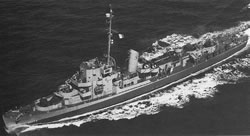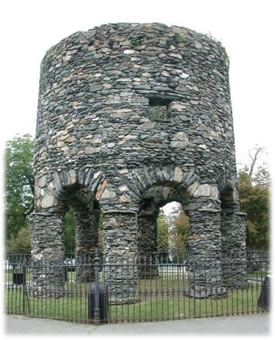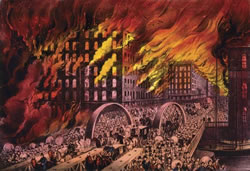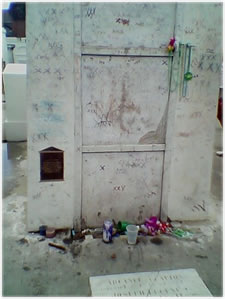- Details
- Written by: G.S. Strange
- Category: Archive
- Hits: 1576

The Philadelphia Experiment: U.S.S. Eldridge
In 1955 Morris K. Jessup, researcher and author of the book The Case for the UFO, received a letter from a man who claimed to have witnessed something quite extraordinary. The man who identified himself as Carlos Allende, later identified as Carl M. Allen, claimed that while serving on board of the S.S. Andrew Furuseth as a merchant marine, witnessed a U.S. Navy experiment involving the invisibility of the U.S.S. Eldridge (DE-173) in the shipyard in Philadelphia. Allende’s letter stated that in October of 1943 large generators were placed on the Eldridge in an attempt to make the ship invisible to radar by using Albert Einstein’s and Nichola Tesla’s “United Field Theory”, which, in theory, bends light around an object. According to Allende, the experiment went horribly wrong. When the generators were turned on a green fog began to shroud Eldridge then she disappeared from the radar monitoring her as well as from the sight of observers. Furthermore, Allende claimed that the 1200 ton ship was teleported over two hundred miles away to Virginia. The ship reappeared in a matter of moments with some crew members fused into parts of the hull, others violently ill, and time pieces showed that the ship had traveled back in time a total of ten seconds. He furthermore claimed that the Office of Naval Research in conjunction with the Central Intelligence Agency had institutionalized the surviving participants in order to keep the experiment also known as “Project Rainbow” a secret.
Jessup began to correspond with Carl Allen. Being a researcher and skeptical of Allen’s claims, he began to investigate the “Philadelphia Experiment”. He quickly discovered that there was no evidence to support Allen’s claims. Then in 1957 Carl Allen struck again when he sent a copy of Jessup’s book The Case for UFOs to the Office of Naval Research. Within the book Allen had extensive annotations in the margins which discussed the “Philadelphia Experiment”, outer space and aliens. The U.S. Navy commissioned the research firm, Vera Corporation to print a revised version of Jessup’s book that included the bizarre notations of Carl Allen. Morris K. Jessup continued to research and write about the subject until his mysterious death in 1959.
The “Philadelphia Experiment” has created a storm of controversy since the time of Jessup and has been the subject of many books, television shows and movies as well as spinning the imaginations of conspiracy theorists who want to believe the allegations of Carl Allen and that the U.S. Navy has withheld the experiment from the public for nearly 70 years.
Let’s look at a few facts!!!!!!!!
- The U.S.S. Eldridge was commissioned in the New York Navel Yard on August 27th, 1943. Her first sea trial was to Bermuda as part of Convoy UGS-23 from September 18th, 1943 , until October 15th. Eldridge returned to and remained in New York until she left for Casablanca on November 3rd as part of Convoy UGS-23.
- The S.S. Andrew Furuseth (Carl Allen’s ship) was part of Convoy USG-22 which left Norfolk, VA. on October 25th, 1943, arriving at Oran in the Mediterranean Sea on November 12th.
- The ship’s logs for the Eldridge and Andrew Furuseth state the neither ship was in the Philadelphia Naval Yard in late October of 1943.
- Crewmembers of the Eldridge who were with the ship from her commissioning until the end of World War II, have stated that they were not a part of any experiment involving invisibility in Philadelphia or any other port.
- The Office of Naval Research that Allen stated was in charge of the experiment and charged with its cover-up was not created until 1946.
- Albert Einstein, who did consult for the U.S. Navy’s Bureau of Ordnance never created or published a Unified Field Theory. Furthermore, Nichola Tesla, who died on January 7th, 1943, never published any document on Unified Field Theory.
- Author/Researcher Robert Goerman, researching the subject in the 1970’s, located Carl Allen and uncovered his history of mental illness. It has been theorized that the “Philadelphia Experiment” was a hoax perpetrated by a troubled mind.
StrangeHistory.org 1 Conspiracy theorists 0
- Details
- Written by: G.S. Strange
- Category: Archive
- Hits: 1397

Newport Tower, Newport Rhode Island
The city of Newport, Rhode Island hosts one of America’s true great mysteries, the Newport Tower. Located in Touro Park, the tower is an odd structure of 28 feet tall, 24 feet wide with a diameter that ranges between 22 feet, 2 inches and 23 feet, 3 inches. The history of the tower is jumbled at best, however it is known that the property was once owned by Governor Benedict Arnold, the great-grandfather of Benedict Arnold, the Revolutionary War traitor. In his will dated 1677, Arnold makes reference to his “stone built Wind Mill” but most historians do not believe that Arnold built the structure (who came to the colonies in 1651) but rather rebuilt it so it could be used as a windmill.
Through the years, testing and comparison tests have been done on the structure’s mortar in an attempt to discover its age and origin. Carbon 14 dating places the age of the structure between 1635 and 1698. Excavations of the site in the 1940’s turned up many artifacts which dated from the early colonial period (1640’s) to the early part of the twentieth century. It has been suggested that the structure has been used for many things through the centuries, including Arnold’s windmill and a hay storage barn.
Some historians believe that the Newport Tower dates back to an even earlier time period citing the Piri Reis Map of 1513 that not only depicts a settlement at modern-day Newport but the tower as well. Some other theories about the tower that reach back even further.
Further in history have it being built by Norse Vikings who, it is believed by some, explored and settled in the northeastern region of North America. Although there is no hard evidence to support these claims a few points that are noteworthy exist. The structure’s windows have astronomical alignments with the summer solstice and important stars as well as a strange symbol carved into one stone, described as a hooked X. The hooked X has also been found at medieval sights in Scotland, England, Scandinavian and most notably, the Kensington Runestone.

Kensington Runestone’s
The Kensington Runestone’s connection to the Newport Tower has never been proven however the theories regarding their connection make for very good strange history.
In 1898, Olof Ohman, a Minnesota farmer, uncovered a stone which measured 31 inches high, 16 inches wide, 6 inches thick and weighed approximately 200 pounds. The stone had a strange inscription on it. Olof believed that he had an ancient Indian artifact until 1907 when Hjalmer R. Holand, a graduate student, translated the inscription. It reads,
“8 Goths and 22 Norweigans on exploration journey from Vinland over the west. We camp by 2 skerries one day-journey from this stone. We were and fished one day. After we came home, 10 men red with blood and tourtured. Hail Virgin Mary, save from evil. Have 10 men by the sea to look after our ship, 14 day -journeys from this island year 1362."
Debates have raged for over a century as to the age and validity of the Kensington Runestone, however there still seems to be no definitive answer. This has opened the door to a great deal of speculation. The leading train of thought is that the inscriptions on the runestone and the Newport Tower, both of which contain the hooked X, were relics of Norse Viking expeditions into the interior of North America. This means that Europeans were on the continent for 130 years before Christopher Columbus began his voyages.
- Details
- Written by: G.S. Strange
- Category: Archive
- Hits: 1503

Chicago Fire
At around 9 p.m. on Sunday, October 8, 1871, Patrick and Catherine O’Leary’s barn on DeKoven Street, not far from downtown Chicago, burst into flames. A mixture of strong winds, an unseasonably dry year and a large amount of wooden structures and homes would be the fuel for the firestorm that would become the Great Chicago Fire of 1871. When the tragedy had passed, 2000 acres had been consumed by fire with the loss of 17,500 buildings and a death toll between two and three hundred.
It was reported by Daniel Sullivan, reporter for the Chicago Tribune, that the fire was started when Mrs. O’Leary’s cow accidentally kicked a lantern onto the hay covered floor of the O’Leary barn.
That is the story as we know it but here’s another theory!
On the night of the Great Chicago Fire, large fires also broke out in Peshtigo, Wisconsin, Port Huron, Michigan, parts of Minnesota and Ontario. In Peshtigo witnesses said that the fire started in the woods outside of the town. Due to the dry conditions the fire spread very quickly. When it was finally contained, the fire had burned twelve cities and towns in a 1.5 million acre area. The Port Huron fire burned nearly 1.2 million acres of land. These two fires together took the lives of over 2500 people in a four day time period. Witnesses in a seven state area within and around the firestorm ravaged area reported seeing balls of fire in the sky just after dark on October 8th.
Shortly after the Great Midwest Fires of 1871, Minnesota Congressman, Ignatius Donnelly wrote a book called “Ragnarok”, which is the Old Norse translation of Fate of the Gods. Congressman Donnelly suggested that the fires were started by Biela’s Comet that was first discovered in 1821 and made an appearance every six years and nine months until 1866. It was set to reappear in 1872 but has not been seen again. An article written in The Athenaeum, the newsletter for the Boston Athenaeum membership library, dated August 8, 1885 stated that Biela’s Comet was seen as a double comet along side of Denning’s Comet in 1852, however Biela’s Comet “underwent violet perturbation through near approach to the earth in 1872.” Meaning that on its way back toward earth for its 1872 appearance it experienced some form of breakup that would have appeared to witnesses in the Midwest as a meteor shower.
A more modern view of this possibility proposed by Physicist Robert Wood states that if Biela’s Comet had come into contact with an asteroid field and broke apart, then the rock and debris could have started fires all over the Midwest. This would explain how such large fires in Wisconsin, Michigan, Illinois, Minnesota and Ontario could have started simultaneously on the night of October 8, 1871.
- Details
- Written by: G.S. Strange
- Category: Archive
- Hits: 1324
“…Marie Laveau’s name will not be forgotten in New Orleans.”

Marie Catherine Laveau: Voodoo Queen of New Orleans (September 10, 1801 – June 15, 1881)
In recalling the famous names that have been attached to Louisiana’s history, Andrew Jackson, Jean Lafitte, Huey P. Long, none can compare to the popularity and fame of Marie Catherine Laveau. Marie was born on September 10, 1801, (although most accounts have her being born in 1794) the illegitimate child of Charles Laveau, a wealthy white planter and Marguerite Darcantrel, a Creole and free person of color. It is believe by some historians that Marie’s mother and grandmother, also named Marguerite were voodoo practitioners.
Voodoo arrived in Louisiana on board of the slave ships from the West African coast. The slaves had a working knowledge of which herbs, plants and roots found in nature had the power to heal and kill. Upon arrival, the slaves were christened Catholic and were orally taught the faith. In Catholicism the slaves found parallels in their own belief systems and in conjunction with their own religious practices involving naturalism, spiritualism and herbalism, voodoo practitioners would create amulets that had the power to heal or cause harm and perform rituals involving drums, prayer and dances designed to bring about a desired effect. Marie Laveau was one such voodoo practitioner.
Although very little is known about her early years, it is known that she was married on August 4, 1819 to Jacque Santiago Paris. The couple was married at St Louis Cathedral on Jackson Square and the service was performed by Father Antonio de Sedella, also known as Pere Antoine. Jacque and Marie’s life together was short lived as Jacque Paris died a year after their marriage. Wild speculation began to circulate throughout the French Quarter about the “mysterious death” of Paris. Marie took up occupation as a hairdresser to the New Orleans wealthy elite women. This gained her access to the gossip of the whites in the city, as well as their servants and slaves who, by that time, believed her to be a powerful voodoo priestess. By all outward appearances Marie Laveau seemed to know, magically, information about her clients and their lives. In a very short time she was thought to have “special powers” as a mystic. With the slave, free persons of color and white communities now believing in her powers, Marie became very popular and sought out by those individuals who wished her to help them.
A year after the death of Jacques Paris, Marie began a relationship with Louis Christophe Dominick Duminy de Glapion who had fought gallantly against the British in the defense of New Orleans. At that time she was being called the “Widow Paris”. For the next forty years Marie Laveau injected herself into every aspect of New Orleans life. She was sought after by members of every social scale within the city. It has been said that the Voodoo Queen of New Orleans had the power to put a person into or out of City Hall. She nurtured the sick through multiple epidemics, stood on the gallows ministering to the condemned and was accused of causing the deaths, through voodoo, of both a lieutenant governor and a governor. Many condemned her as a witch while others praised her as a saint.
By all accounts Marie stopped practicing voodoo publicly in the 1860’s, however legend states that she continued until the early 1870’s when her daughter, Marie Laveau II took up her position as the Voodoo Queen of New Orleans. Marie Laveau II was known for her wild rituals in the swamps around New Orleans and was said to have drowned in 1897 while crossing the flooded Lake Pontchartrain.
Marie Catherine Laveau, the Voodoo Queen of New Orleans passed this life on June 15, 1881, three days after her death, the New Orleans Daily Picayune printed this article:
Death of Marie Laveau

Marie Catherine Laveau is buried in a mausoleum in St. Louis Cemetery
“Those who have passed by the quaint old house on St. Ann, between Rampart and Burgundy streets with the high frail looking fence in front over which a tree or two is visible, have been within the last few years, noticed through the open gateway a decrepid old lady with snow white hair, and a smile of peace and contentment lighting up her golden features. For a few years past she has been missed from her accustomed place. The feeble old lady lay upon her bed with her daughter and grand children around her ministering to her wants.
On Wednesday the invalid sank into the sleep, which knows no waking. Those whom she had befriended crowded into the little room where she was exposed, in order to obtain a last look at the features, smiling even in death, of her who had been so kind to them.
At 5 o’clock yesterday evening Marie Laveau was buried in her family tomb in St. Louis Cemetery No. 1. Her remains were followed to the grave by a large concourse of people, the most prominent and the most humble joining in paying their last respects to the dead. Father Mignot conducted the funeral services. A year afterwards Mr. Paris disappeared, and knows one knows to this day what became of him. After waiting for a year for his return she married Capt. Christophe Glapion. The latter was also very prominent here, and served with distinction in the battalion of men of San Domingo, under D’Aquin, with Jackson in the war of 1815.
Fifteen children were the result of their marriage. Only one of these is now alive. Capt. Glapion died greatly registered, on the 26th of June, 1855. Five years afterwards Marie Laveau, became ill, and has been sick ever since, her indisposition becoming more pronounced and painful within the last two years.
Besides being very beautiful Marie also was very wise. She was skilled in the practice of medicine and was acquainted with the valuable healing qualities of the indigenous herbs.
She was very successful as a nurse, wonderful stories being told of her exploits at the sickbed. In yellow fever and cholera epidemics she was always called upon to nurse the sick, and always responded promptly. Her skills and knowledge earned her the friendship and approbation, of those sufficiently cultivated, but the ignorant attributed her success to unnatural means and held her in constant dread.
Notably in 1853 a committee of gentlemen, appointed at a mass meeting held at Globe Hall, waited on Marie and requested her on behalf of the people to minister to the fever stricken. She went out and fought the pestilence where it was thickest and many alive today owe their salvation to her devotion.
Not alone to the sick man was Marie Laveau a blessing. To help a fellow citizen in distress she considered a priceless privilege. She was born in the house where she died. Her mother lived and died there before her. The unassuming cottage has stood for a century and a half. It was built by the first French settlers of adobe and not a brick was employed in its construction. When it was erected it was considered the handsomest building in the neighborhood. Rampart street was not then in existence, being the skirt of a wilderness and latterly a line of entrenchment. Notwithstanding the decay of her little mansion, Marie made the sight of it pleasant to the unfortunate. At anytime of night or day one was welcome to food and lodging.
Those in trouble had but to come to her and she would make their cause her own after undergoing great sacrifices in order to assist them.
Besides being charitable, Marie was also very pious and took delight in strengthening the allegiance of souls to the church. She would sit with the condemned in their last moments and endeavor to turn their last thoughts to Jesus. Whenever a prisoner excited her pity Marie would labor incessantly to obtain his pardon, or at least commutation of sentence, and she generally succeeded.
A few years ago, before she lost control of her memory, she was rich in interesting reminiscences of the early history of the city. She spoke often of the young American Governor Claiborne, and told how the child-wife he brought with him from Tennessee died of yellow fever shortly after his arrival with the dead babe upon her bosom was buried in a corner of the old American Cemetery. She spoke sometimes of the strange little man with the beautiful bright eyes Aaron Burr, who was so polite and so dangerous. She loved to talk of Lafayette, who visited New Orleans over half a century ago. The great Frenchmen came to see her at her house, and kissed her on the forehead at parting.
She remembered the old French General, Humbert, and was one of the few colored people who escorted to the tomb long since dismantled in the catholic Cemetery, the withered and grizzly remains of Castlebar. Probably she knew Father Antoine better than any living in those days – for he the priest and she the nurse met at the dying bedside of hundreds of people – she to close the faded eyes in death, and he, to waft the soul over the river to the realms of eternal joy.
All in all Marie Laveau was a most wonderful woman. Doing good for the sake of doing good alone, she obtained no reward, oft times meeting with prejudice and loathing, she was nevertheless content and did not lag in her work. She always had the cause of the people at heart and was with them in all things. During the late rebellion she proved her loyalty to the South at every opportunity and fully dispensed help to those who suffered in defense of the “lost cause.” Her last days were spent surrounded by sacred pictures and other evidences of religion, and she died with a firm trust in heaven. While God’s sunshine plays around the little tomb where her remains are buried, by the side of her second husband, and her sons and daughters, Marie Laveau’s name will not be forgotten in New Orleans.”

